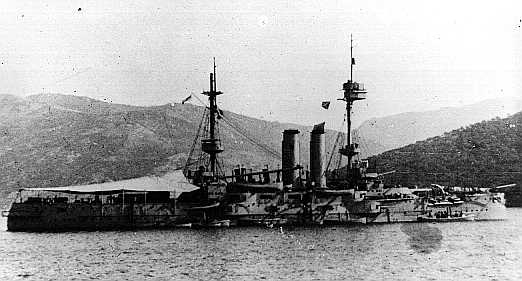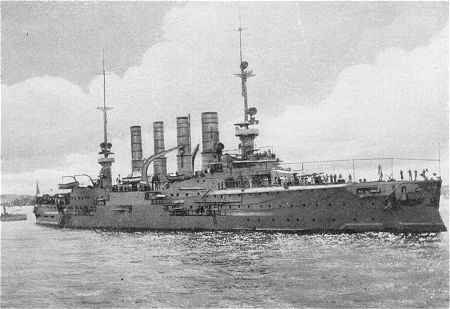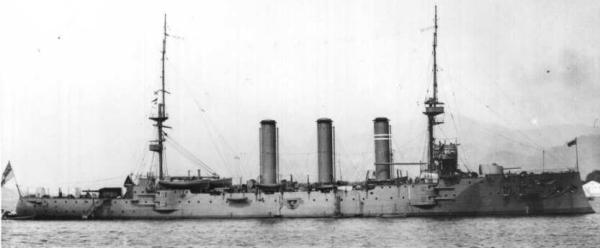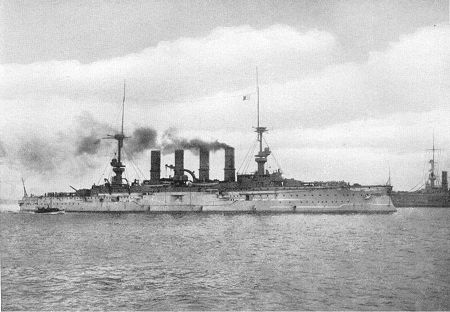 |
 |
|
|
|
BATTAGLIE NAVALI DI CORONEL E FALKLAND
NAVAL BATTLES OF CORONEL AND FALKLAND'ISLANDS
(NOVEMBRE - DICEMBRE 1914)
L'ULTIMA CROCIERA DELL'AMMIRAGLIO SPEE
(TRATTO DA ARTICOLI DEL PROF. FRANCESCO LAMENDOLA - ARIANNA EDITRICE)
 |
 |
|
|
|
STORIA
HISTORY
LA BATTAGLIA NAVALE DEL CORONEL
- 1° NOVEMBRE 1914 -
THE NAVAL BATTLE OF CORONEL - 01.11.1914 -
(Tratto da articoli gentilmente concessi dal Prof. FRANCESCO LAMENDOLA)
Il mattino del 26 ottobre la squadra tedesca giunse in vista della costa occidentale di Mas a Fuera, nel gruppo cileno delle isole Juan Fernandez, le cui rocce prive di vegetazione cadono al mare con un solo balzo di oltre 1.500 metri. Gli equipaggi di von Spee vi trascorsero alcuni giorni di duro lavoro per l'imbarco del carbone dalle navi ausiliarie. Era quella l'ultima sosta prima di giungere sulla costa occidentale americana e offriva il prezioso vantaggio di prolungare l'ignoranza dell'avversario circa la posizione della squadra, essendo l'isola disabitata. La squadra salpò le ancore la notte del 28 ottobre e scortò le navi da carico fino in vista delle acque neutrali del Cile; vi fu anche un incontro inatteso con il Prinz Eitel Friedrich che aveva lasciato il Pacifico occidentale per le difficoltà di rifornimento di carbone.

Mentre von Spee volgeva la prora a sud, la IV squadra incrociatori britannica risaliva lungo la costa del Cile e aveva distaccato il Glasgow per ritirare e spedire dispacci nel porto di Coronel: esso vi entrò la sera del 31 ottobre. Quella notte stessa un piroscafo tedesco che si trovava in rada ne informò radiotelegraficamente l'ammiraglio von Spee, che subito diresse verso quel porto per bloccare le due uscite della baia di Arauco (a nord e a sud dell'isola di Santa Maria) per attendervi il Glasgow e distruggerlo non appena fosse uscito. Infatti il regolamento marittimo internazionale stabiliva che la nave da guerra di una nazione belligerante non potesse sostare nel porto di uno Stato neutrale per più di 24 ore, pena l'internamento e il disarmo.
All'alba del 1° novembre il vapore tedesco Titania catturò un veliero norvegese che trasportava carbone per conto del governo britannico e lo condusse a Mas a Fuera; anche il Nürnberg si separò dalla squadra per inseguire un veliero. Il resto della formazione procedeva al largo della costa cilena in direzione sud e poiché solo il Leipzig (intenzionalmente) aveva fatto uso della radio, l'ammiraglio Cradock incorse nello stesso equivoco del suo avversario: credette, cioè, di aver di fronte una sola nave della formazione tedesca.

Le due squadre entrarono in contatto visivo nel pomeriggio, con un mare che continuava a ingrossare; esse seguivano due rotte parallele e leggermente convergenti in direzione sud, i Tedeschi più presso la costa, gli Inglesi (cui si era ricongiunto il Glasgow) all'esterno. Pur disponendo di forze nel complesso inferiori, sir Cradock cercò di sfruttare il favore del sole al tramonto, che illuminava le sagome delle navi avversarie, e strinse le distanze per dare battaglia quanto prima possibile; ma von Spee, per le stesse ragioni tattiche, volle ritardare lo scontro e si sottrasse con una serie di accostate, sfruttando la sua maggiore velocità. Certo era stato un grave errore, da parte inglese, quello di portarsi dietro il lento Otranto che, coi suoi 15 nodi orari, non faceva altro che rallentare la marcia della squadra e fece passare il momento ad essa favorevole. Quando il sole tramontò, i profili delle navi inglesi si stagliarono nettamente contro il cielo rossastro a occidente, mentre quelle tedesche si confondevano contro la linea scura della costa. A questo punto von Spee decise di serrare le distanze e alle 19,02 l'ammiraglia Scharnhorst aprì il fuoco.
Fin dalle prime salve le navi corazzate tedesche inquadrarono quelle inglesi e le martellarono implacabilmente con le bordate da 210 mm. (peso di una granata: 125 kg.). Gli Inglesi si batterono valorosamente, ma il loro tiro risultò debole e impreciso; presto entrambi gli incrociatori corazzati britannici furono avvolti dagli incendi. Alle 19,15 incominciò a cadere la notte e il Monmouth, semidistrutto dal tiro del Gneisenau, si allontanò sul mare in tempesta; allora la nave tedesca si unì allo Scharnhorst nel martellare il Good Hope ormai in preda alle fiamme. Frattanto l'Otranto era stato messo in fuga dal tiro del Dresden che, allora, si unì al Leipzig contro il Glasgow.

Quest'ultimo lottò eroicamente, fronteggiando le due navi leggere avversarie e, anzi, coi suoi due pezzi da 152 mm. tirò anche contro le navi corazzate finché, quando anche il Gneisenau si volse contro di esso, non poté fare altro che allontanarsi lanciando inutili richiami di soccorso al Canopus, che era ancora troppo lontano per poter intervenire.
Il Good Hope affondò alle 20,09 con tutto l'equipaggio e col valoroso ma sfortunato ammiraglio Cradock. Nello stesso tempo il Monmouth, che andava alla deriva nell'oscurità, venne sorpreso dal Nürnberg che giungeva solo allora sul luogo dello scontro e, non potendo più sparare, gli si avvicinò per tentare di speronarlo, ma fu distrutto dal tiro accelerato dei pezzi da 105 mm. e scomparve tra i flutti tempestosi, alle 21,25, trascinando con sé l'intero equipaggio.
La battaglia navale di Coronel costituì un grave colpo per il prestigio britannico nel Sud America e vide una temporanea interruzione del controllo alleato sulle rotte oceaniche fra Atlantico e Pacifico.
La sconfitta era stata pressoché inevitabile, in quanto l'Ammiragliato di Londra aveva affidato al Cradock un compito chiaramente superiore alle forze che gli aveva messo a disposizione. Da parte tedesca, la vittoria fu il più brillante risultato di tutta la guerra mondiale con le navi di superficie; essa fu ottenuta da una squadra-fantasma sbucata quasi di sorpresa all'altra estremità dell'oceano più grande del globo e che aveva saputo mantenere un altissimo grado di efficienza combattiva dopo un viaggio di 10.000 miglia, effettuato senza poter contare su un solo porto amico e superando enormi difficoltà logistiche legate al carbonamento.
THE NAVAL BATTLE OF CORONEL - 01.11.1914 -
The morning of October 26 the German team reached Fuera in sight of the western coast of Mas, in the Chilean group of the islands Juan Fernandez, of whose deprived rocks of vegetation fall to the sea with a solo leap over 1.500 meters. The crews of von Spees spent you some days of hard job for the embarkation of the coal from the auxiliary ships. It was that the last standstill before coming on the American western coast and he/she offered the precious advantage to prolong the ignorance of the adversary around the position of the team, being the uninhabited island. The team set sail the anchors the night of October 28 and escorted the thin load ships in sight of the neutral waters of Chile; there was also an unexpected meeting with the Prinz Eitel Friedrich that he left the western Pacific for the difficulties of coal restocking.
While von Spee turned the south bow, the IV it quadrates cruisers British it went up again along the coast of Chile and you/he/she had detached the Glasgow to withdraw and to send dispatches in the I bring of Coronel: it entered the evening of October 31. That same night a German steamboat that was found in roadstead informed radiotelegraficamente of it the admiral von Spee, that immediately directed toward that I bring for stopping the two exits of the bay of Arauco (to north and south of the island of Saint Maria) to attend you the Glasgow and to destroy not it as soon as you/he/she was gone out. In fact the international maritime rule established that the war ship of a belligerent nation could not stop in the I bring of a neutral State for more than 24 hours, punishment the internment and the disarmament.
To the dawn of November 1° the German vapor Titania captured a Norwegian veliero that transported coal on behalf of the British government and it conducted him/it to Mas to Fuera; also the Nürnberg separated him from the team to pursue a veliero. The rest of the formation proceeded offshore the Chilean coast in south direction and since only the Leipzig (intentionally) you/he/she had made use of the radio, the admiral Cradock incurred in the same misunderstanding of his/her adversary: credette, that is, to have of forehead an alone ship of the German formation.
The two teams came into visual contact in the afternoon, with a sea that kept on thickening; they followed two parallel routs and slightly convergent in south direction, the more Germans near the coast, the English (which the Glasgow was rejoined) to the outside. Also having overall inferior strengths, sir Cradock tried to exploit the favor of the sun to the sunset, that illuminated the outlines of the ships avversarie, and it tightened the distances to give as soon as possible possible battle; but von Spee, for the same reasons tactics, wanted to delay the clash and escaped with a series of you approach, exploiting his/her greater speed. You/he/she had certainly been a serious error, aside English, that to go himself/herself/themselves behind the slow Otranto that, with his/her 15 hourly knots, it didn't do anything else other than to slow down the march of the team and it made to pass the moment to it favorable. When the sun tramontò, the profiles of the ships English clearly hacked him against the reddish sky to west, while those German confused him against the dark line of the coast. To this point von Spee decided to shut the distances and at 19,02 o'clock the flagship Scharnhorst it opened the fire.
Since the first salutes the ships armored German framed those English and they implacably hammered her with the broadsides from 210 mms. (hangs of a broom: 125 kgs.). The English bravely fought, but their draught resulted weak and inaccurate; soon both the cruisers armored British were wound by the fires. At 19,15 o'clock it began to fall the night and the Monmouth, semidistrutto from the draught of the Gneisenau, got further on the sea in storm; then the German ship united him to the Scharnhorst in to hammer the Good Hope by now prey to the flames. In the meantime the Otranto had been put in escape by the draught of the Dresden that, then it united him to the Leipzig against the Glasgow. This last heroically fought, facing the two light ships avversarie and, rather, with his/her two pieces from 152 mms. it also threw against the ships armored until, when also the Gneisenau turned him against it, it could not do anything else other than to get further launching useless calls of help to the Canopus, that was too far still to be able to intervene.
The Good Hope sank at 20,09 o'clock with the whole crew and with the brave but unlucky admiral Cradock. At the same time the Monmouth, that went adrift to the obscurity, was surprised by the Nürnberg that it came then only on the place of the clash and, not could shoot anymore, it drew near him to try of speronarlo, but it was destroyed from the draught accelerated of the pieces by 105 mms. and it disappeared among the tempestuous billows, at 21,25 o'clock, dragging with itself the whole crew.
The naval battle of Coronel constituted a serious hit for the British prestige in South America and saw a temporary interruption of the allied control on the oceanic routs between Atlantic and defeated Pacifico.
The defeat had nearly been inevitable, in how much the admiralty in London had clearly submitted a superior assignment to the Cradock to the strengths that you/he/she had made him available. Aside German, victory was the brightest result of the whole world war with the ships of surface; it was gotten by a team-ghost almost emerged of surprise to the other extremity of the greatest ocean of the globe and that you/he/she had known how to maintain a tall degree of combative efficiency after a trip of 10.000 miles, effected without being able to count on a solo I bring friend and overcoming enormous logistic difficulties tied to the carbonamento.
BATTAGLIE NAVALI DEL CORONEL E DELLE FALKLAND / NAVAL BATTLES OF CORONEL AND OF FALKLAND'ISLANDS
LE PIU' GRANDI BATTAGLIE NAVALI /NAVAL BATTLES
NAVI DA GUERRA / WARSHIPS AND BATTLESHIPS
PORTAEREI NELLA STORIA /AIRCRAFT CARRIERS